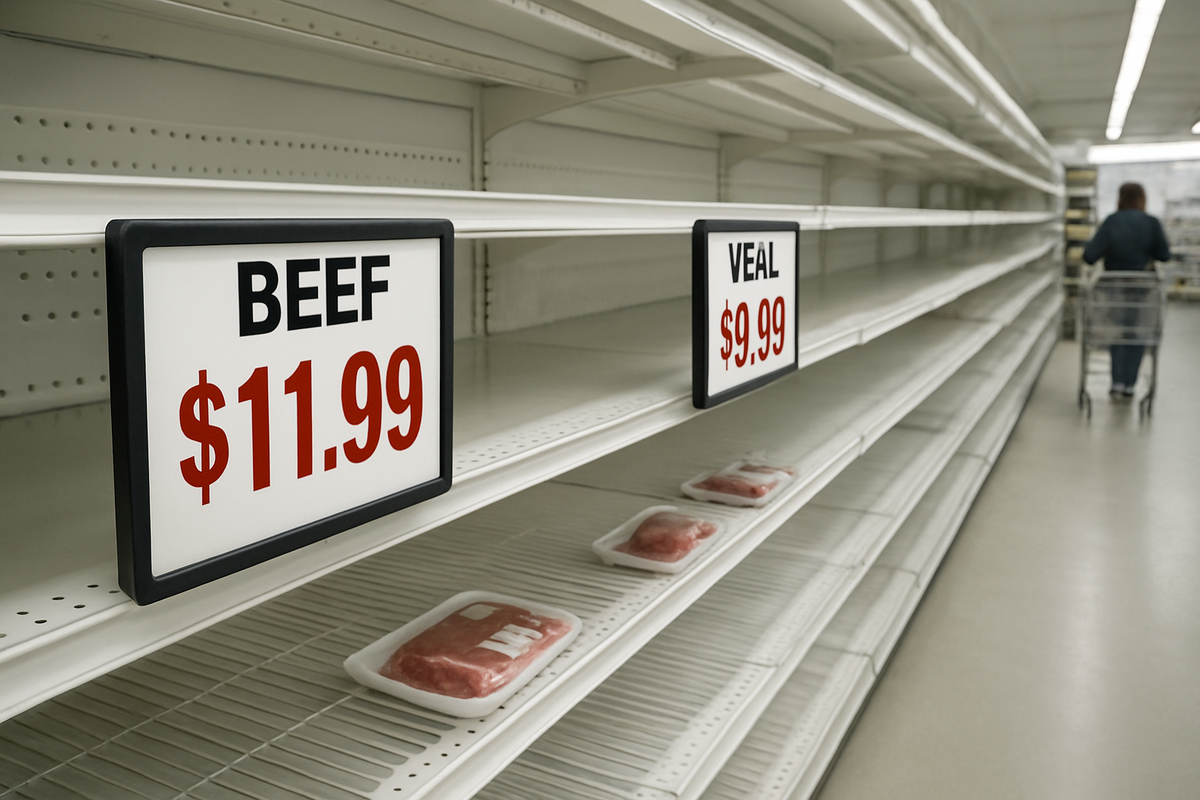
As of late October 2025, American consumers are grappling with a significant and persistent surge in meat costs, with beef and veal prices leading the charge. These essential proteins have seen a staggering nearly 15% increase over the past year, acting as a powerful accelerant to broader grocery inflation and placing considerable strain on household budgets nationwide. This sustained upward trend is forcing consumers to make difficult choices at the checkout counter and prompting a reevaluation of dietary staples, while industry stakeholders navigate a complex web of supply shortages, robust demand, and escalating production costs.
The escalating prices of beef and veal are not a fleeting phenomenon but rather the culmination of several interconnected factors that have been building throughout 2025. By September 2025, the year-over-year increase for beef and veal collectively reached 14.7%, a trend that has accelerated every month since May. Specific cuts have been hit even harder, with uncooked beef roasts surging 18.4%, raw beef steaks 16.6%, and uncooked ground beef 12.9% year-over-year. Ground beef, a household staple, has notably surpassed $6 per pound, hitting $6.30 in August. This dramatic climb is primarily attributed to the smallest U.S. cattle inventory since 1951, a direct result of ranchers reducing herds due to prolonged drought conditions in key cattle-producing regions and soaring feed prices. Despite these supply constraints, consumer demand for beef has remained remarkably resilient, further exacerbating the price pressure. The U.S. Department of Agriculture (USDA) forecasts an 11.6% increase for beef and veal prices in 2025, indicating that relief is not on the immediate horizon.
Industry Players Face Shifting Tides
The landscape created by these soaring meat prices presents a mixed bag for key players in the food industry. Ranchers, particularly those who have managed to maintain or slightly expand their herds, are currently experiencing record-high cattle prices and profitable operating margins. However, the overall trend of herd reduction signals long-term challenges for the sector. Meatpacking giants like Tyson Foods (NYSE: TSN) and JBS S.A. (OTC: JBSAF) face the complex task of balancing high input costs (the price they pay for cattle) with consumer resistance to ever-increasing retail prices. While they have historically demonstrated pricing power, sustained high prices could eventually lead to reduced sales volumes.
Grocery retailers, including major chains like Kroger (NYSE: KR) and Walmart (NYSE: WMT), are at the forefront of consumer backlash. They must decide how much of the increased wholesale cost to pass on to shoppers, risking lower sales for high-priced beef or absorbing some costs, which could squeeze their already tight profit margins. Many retailers are likely to promote alternative proteins such as chicken and pork more aggressively to mitigate the impact. The restaurant industry is also feeling the pinch, with eateries ranging from fine dining establishments to fast-casual chains like McDonald's (NYSE: MCD) needing to adjust menus, portion sizes, or pricing to cope with the elevated cost of beef, a cornerstone of many popular dishes. Consumers, the ultimate stakeholders, are experiencing "sticker shock" and are increasingly exploring more affordable protein options, indicating a potential long-term shift in purchasing habits.
Wider Implications and Economic Ripples
The surge in beef and veal prices is not an isolated event but a critical component of broader inflationary pressures gripping the economy. In September 2025, overall food-at-home prices rose 2.7% year-over-year, with the meat, poultry, fish, and eggs category seeing a 5.2% increase. The disproportionate rise in beef prices—averaging 15.6% year-over-year for foods affected by extreme weather—is more than four times the average for other food items, highlighting its significant contribution to grocery bills. This trend exacerbates food insecurity for low-income households, who are already struggling with rising utility costs and stagnant wages.
Regulatory and policy discussions are intensifying. The USDA has announced initiatives aimed at "strengthening the American beef industry" through ranch support and processing capacity enhancements, with a long-term goal of lowering consumer costs. This includes exploring increased grazing access and streamlined regulations. However, controversial proposals to boost beef imports from countries like Argentina to alleviate consumer prices have met strong opposition from organizations like the National Cattlemen's Beef Association (NCBA), which argues such moves would harm domestic producers. Historically, the U.S. cattle herd has rebounded from similar lows, but the current confluence of severe drought, high feed costs, and robust demand makes this recovery particularly challenging and potentially protracted.
The Road Ahead: Navigating Volatility
Looking forward, industry analysts largely agree that beef prices will remain "tumultuous" for the next two to four years. The rebuilding of the U.S. cattle herd is a lengthy biological process, requiring time for retained heifers to calve and for their offspring to reach market weight. This means that significant price reductions are unlikely in the short term. In the interim, consumers can expect continued high prices and will likely further adapt by diversifying their protein sources. This could create market opportunities for producers of poultry, pork, and plant-based protein alternatives, which may see increased demand.
Strategic pivots will be essential for businesses across the supply chain. Grocery retailers may focus on private-label meat brands or expand their offerings of frozen and processed meat products to provide more affordable options. Restaurants will continue to innovate with menu engineering, perhaps featuring less beef or exploring global cuisines that utilize alternative proteins. Policy makers will face ongoing pressure to balance consumer affordability with the economic viability of domestic ranchers. The evolution of climate change and its impact on agricultural productivity will also remain a critical long-term factor influencing commodity prices.
A Persistent Challenge for Consumers and Markets
The continued surge in beef and veal costs, nearing a 15% annual increase, represents a significant and persistent challenge for American households and the broader financial markets. It underscores the fragility of food supply chains in the face of environmental stressors and economic pressures. While ranchers currently benefit from high cattle prices, the long-term health of the industry hinges on herd rebuilding and sustainable practices. For consumers, the immediate future points to continued vigilance over grocery budgets and an increased willingness to explore diverse protein options.
Investors should closely watch the quarterly earnings reports of major food retailers, meatpackers, and restaurant chains for insights into how these companies are managing cost pressures and shifts in consumer behavior. Any significant policy changes regarding agricultural subsidies, import tariffs, or environmental regulations could also have a profound impact. The beef market's trajectory over the coming months will serve as a bellwether for broader food inflation trends, making it a critical area of focus for economic observers and consumers alike.
This content is intended for informational purposes only and is not financial advice






